Current Projects
I am equally interested in developing new technologies (which invariably end up producing exciting new science), and pursuing an observational program in extragalactic astronomy. Nowadays, the emphasis is more on the technical side, so that's where I shall start...
I. Submillimeter Technologies
GPU-based Detector Readout
What prevents us from building megapixel submillimeter cameras today is that we cannot currently handle the multitude of signals they would produce. The readout challenge has to be solved before we can realize large-format submillimeter arrays.
To realize submillimeter cameras with 100 thousand or a million pixels, we need increased multiplexing of the detectors. At minimum, a few thousand detectors need to share a single readout line, for a total cost (production + readout) of $1/pixel or less.
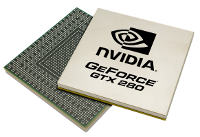
My approach is unique in its use of commercial electronics and exploiting the processing power of graphical processors (GPUs). The advantage of commercial components, as opposed to custom-made electronics, is that they get faster, better, and cheaper (see Moore's law) at no cost to us. At the same time, the GPUs are already powerful enough to allow complete spectral processing (FFTs) of millions of points, at several thousand times a second.
With our current system (PC + digitizer & signal-generator + GPU at around $20K), we can fully process an octave bandwidth up to 250 MHz today, and operate it either with a discrete set of tones, or via chirp-pulse excitation with full-spectrum readout. Unlike the FPGA alternatives, the GPU-based system makes no compromises. The chirp-mode readout is potentially a unique advantage of the GPU system over FPGAs, and allows far more sophisticated real-time signal processing, for example, on-the-fly resonance fitting several thousand times a second.
If we can reduce the cost of the system substantially over the coming years, then our GPU-based approach might be the one that enables the megapixel submillimeter cameras of the future.
CRUSH
Solving the readout challenge (above) will enable a new generation of large-format submillimeter cameras. The next challenge is: how do we analyze/reduce the resulting volume of data (100 GB to 10 TB per hour!) in real-time, or preferably an order of magnitude faster?
Achieving such a dramatic enhancement in speed will likely require a three-pronged approach: (1) computing hardware gets faster, with speeds doubling every 18 months (roughly) – so we can expect an order of magnitude increase in speed by 2020; (2) More parallel deployment, e.g. on the pooled computing resources of a lab, or on graphical processors (GPUs) can result in an enhancement of speed by an order of magnitude or more; and (3) cleverer, faster algorithms can provide further improvements by up to a factor of a few.
Therefore, my goal over the next few years is to adapt CRUSH for massively parallel platforms (both GPUs and clusters!), and continue the search for powerful new algorithms at the cutting edge of data reduction science. For further information on CRUSH, please check out the CRUSH website.
SOFIA/HAWC+
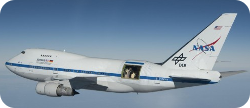
My role in this project is to provide the imaging data reduction facility (CRUSH, see above), the in-flight real-time instrument diagnostics, and the data analysis for detector testing and development. It is also possible that CRUSH will eventually enable a rotating waveplate, scan-mode polarimetry – like G. Siringo and I have demonstrated for PolKa on APEX – although probably not before commissioning of the instrument.
SuperSpec / X-Spec

Matt Bradford is leading the collaboration to realize such devices at Caltech/JPL (SuperSpec). We are close to demonstrating a prototype device and we hope to deliver single-pixel spectrometer for the LMT within a year, matching or exceeding the capabilities of Z-Spec. In the longer term, we hope to build a 10 to 100 pixel spectrometer camera (X-spec concept) to performs redshift surveys of the submillimeter population on a large mm-wave telescope, or to provide spatially unresolved C+/CO itensity mapping, and trace chemical evolution, of the universe on a smaller dedicated survey telescope.
GISMO-2
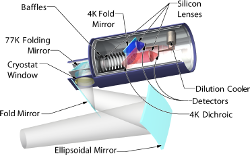
My role in GISMO-2 began with suggested improvements (e.g. stray-light rejection, detector wiring), and I will provide its real-time diagnostics, and data reduction facility with CRUSH (see above). GISMO-2 may make its debut on the JCMT in 2016-2017. Stay tuned!
II. Observational Astrophysics
Deep Fields
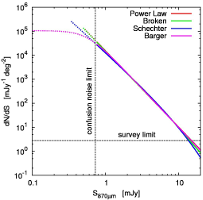
Nowadays, I am mainly involved in the deep-field science through the GISMO 2-mm camera. We are publishing the first ever 2-mm deep-field (J. Stagughn et al. 2013, submitted), for which I provided the optimal the data reduction, source extraction, flux deboosting, statistical analysis, and SED (Spectral Energy Distribution) fitting. As we continue with this work, I will focus on bringing the first number-count distribution of 2-mm sources(!), and we pursue a number of follow-up studies for our new detections. Secondly, we are continuing with the degree-scale mapping of the COSMOS field.
Dust SED Models
Our understanding of the physical characteristics of star-formation and dust heating is only as good as the models we use to interpret the observations.
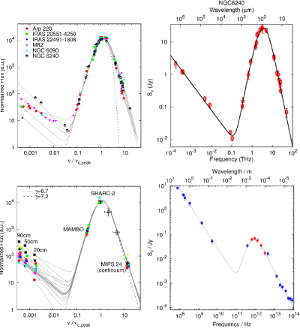
The most popular approach today to capture the complexity is to derive spectral energy distribution (SED) templates by radiative transfer modeling. Such template fitting has become the bread-and-butter of far-infrared characterization of extragalactic sources. However, radiative transfer models have many shortcomings and pitfalls.
First of all, they assume over-simplistic geometries (spherical, centrally illuminated gas, or slab of gas uniformly illuminated from outside, etc.) Secondly, they have lots of hidden parameters, such as density profiles or composition. Third, they account only for radiative heating, but not for heating of gas by shocks or collapse (the latter is especially important, since dust plays a crucial role in star-formation in radiating heat in the formation process, before stars can ignite!).
Yet, the greatest of all problems with radiative transfer models is that they cannot, by their design, describe an entire galaxy comprehensively. Galaxies comprise of a multitude of gas clouds, each with different geometries, turbulence, different sources of heating (embedded stars, YSOs, collapsing cores, turbulent shocks, cosmic rays, and/or externally illumination). No single radiative transfer model, assuming just one particular geometry and heating configuration, will ever successfully capture this plurality.
My goal, therefore, is to provide an alternative framework for modeling thermal dust SEDs, one which provides just as accurate characterization (or better!), but succeeds where radiative transfer models fail. My emphasis is on the empirical and descriptive, rather then purely theoretical models. I model the thermal emission of galaxies as a powerlaw distribution of discrete temperature components (dM/dT ~ T-γ). Powerlaws are common (e.g. the initial mass function, brightness distribution of sources etc.), and can arise both on the macro and micro scales. We do not have to know exactly where observed power law comes from in order to characterize it – the powerlaw could be a property of individual clouds, or could arise from the distribution of a large number of clouds with different underlying properties, e.g. each with its own geometry and heating. The only thing that matters is whether it accurately describes what we see or not. And, it does the job, quite well.
The powerlaw temperature distribution is also attractive. It has few parameters (just the powerlaw index γ in excess of an equivalent single-temperature model). It allows for easy fitting of all properties (Md, T, β, γ, emission size), and calculating luminosities analytically. And, perhaps most importantly, it does away with all the questionable assumptions that plague radiative transfer models.
Currently, I'm working on releasing my code into in the public domain, for use by astronomers. A future refinement might be to extend the modeling from purely thermal emission to include features, such as PAH, silicate absorption, or even bright line emission.